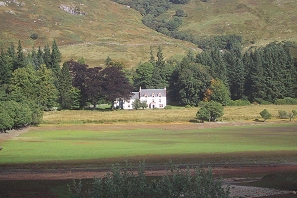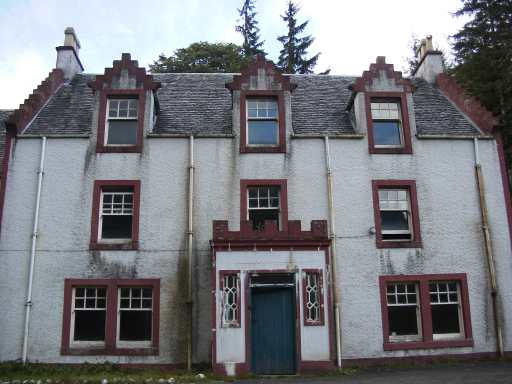
 |
Glengyle House - built by Rob Roy MacGregor |
| By Peter Lawrie, ©2004 |
| Glen Gyle House was sold at auction in Glasgow on 24th November 2004 for £470,000.
It subsequently appeared that this sale may have been a part of a criminal money laundering scheme. We understand that the house has now been sold again and may have a brighter future. In a separate transaction the Glengyle Steadings have been developed into holiday letting apartments. From 1918 until the early 1980s the Glasgow Corporation Water Board cared for the house and used it to house three families of estate workers. West of Scotland Water preferred to use contract workers and allowed the house to become run down and in danger of dereliction. At long last, the house now has new owners and it is to be hoped that they will be caring owners, prepared to restore the house in keeping with its history and status. In view of the extensive interest in the sale, an article written by John MacGregor in 1926 detailing the history of the house has been given below. |
 |
The house stands assertively at the head of Loch Katrine, visible for miles along the south
shore. The Glengyle MacGregors were asserting their presence and importance
in the landscape with this bold architectural statement. The house is not deep and the ceilings are low. The western block was added in the 19th century and the westernmost extension of it after 1918. Pictures and floorplan with thanks to Nancy W Johnson. |
| By the purchase of the estate of Glengyle, the Corporation of Glasgow now
owns the whole lands round the shores of Loch Katrine. Truly the wheel
of time brings many changes and one wonders what Rob Roy would have said
had he seen, as I have done, a successor of Bailie Nicol Jarvie residing
in the family mansion. This small property, extending to about 2200 acres, is situated at the extreme west end of Loch Katrine. The Loch for rather more than a quarter of a mile and the Glengyle water for another two and a half miles form its southern boundary. To the north the property is separated from the Braes of Balquhidder by the hill tops, which rise to a height of over two thousand feet. The dwelling house, a two storied building with attic or storm windows above, is pleasantly situated facing towards the south, and overlooks the west end of Loch Katrine. It is sheltered from the west and north by a strip of trees, in which there is a small burying ground. In front of the house is a grassy field, which slopes gently to the level of the loch. Glengyle at one time formed a portion of the extensive estates of the Buchanans of that ilk. The last male of the old family to possess the property was John Buchanan, who died before September 1631, leaving two daughters, and his lands were purchased from his creditors by James, 3rd Marquis of Montrose. |
 |
| To the Memory of Gregor M'Gregor of Glengyle, who died 21st August, 1777, aged 88. Not with vain flatt'ry to insult thee dead We place this stone above thy honour'd head But that, while wand'ring here, the Good and Brave May sighing pause to mark thy silent grave And awful o'er thine ashes as they bend, Think on their Chief their Father or their Friend Speak of thy Steady Soul, and martial flame That burnt for Truth and Virtue more than fame, And tell their sons to hold thy Mem'ry dear Thy footsteps follow and thy name revere. |
|
Over the door of Glengyle House there is a stone inscribed as follows- 1704 J. M'G J.B. G. M'G. 1726 M.H. |
|
|
Obviously the inscription
was not carved in 1704, for as we have seen the house was only built in
1707. The initials "G.M'G and M.H. stand for Gregor MacGregor and
his wife Mary Hamilton, who were married in 1708 as mentioned above. "J.M'G and J.B. stand for John MacGregor, the eldest son of Gregor Ghlun dubh, and his wife. John was born in 1708, and died before his father in 1774. He married Jean, daughter of William Buchanan of Craigievairn. I am not aware of the reason for putting the date 1726, as their marriage does not appear to have taken place until about the year 1743. The remains of John MacGregor, who died on december 30, 1774, are also interred in the small burying ground. John MacGregor was succeeded in the representation of the family of Clan Douill Chere by his son James, who was at one time a quartermaster in the 105th regiment. He was twice married. His first wife was Isabella, daughter of Captain Gregor MacGregor of the family of Inverardran, whom he married in the year 1777. She died in 1789, and left four daughters. His second wife was Henrietta, daughter of Alexander MacGregor in Ardmacmuin, which place is also situated on the north shore of Loch Katrine, to the eastward of Glengyle. In 1791, while droving a flock of sheep, James Hogg, the Ettrick Shepherd had to get permission to drive them through Glengyle. He went to Glengyle House to get permission. The laird, he says, "was then an old man, and seemed to me to be a very queer man” but his lady granted my request without hesitation, and seemed to me an active, social woman. This was, of course, John's second wife. By her he had three sons. The two eldest dying in infancy, James was succeeded by his only surviving son John. John MacGregor served for some time in the West Kent Militia and married in 1816 Jane Isabella the daughter of Captain Daniel MacGregor who was the brother of John's first wife, and had three sons, James, John Daniel and Gregor. When the Commissioners of the Glasgow Corporation Waterworks Act 1855, proposed to raise the level of Loch Katrine, with the result that part of Glengyle would be submerged, he lodged a claim for compensation. In this claim he states that "the property has been in the family of the claimant for hundreds of years, and possesses a distinction of the highest value to him and his family as the birthplace and last resting place of a long line of ancestors, who were in succession the chiefs of his race and clan. The effect of raising the level, he says, will be in winter and during seasons of long continued rain, the land will be covered with water, but in summer and autumn his beautiful green meadow will be converted into an unsightly, offensive and unwholesome swamp, exhibiting only decayed and decaying vegetation, and polluting the atmosphere with most offensive odours and exhalations. The compensation he claimed for the portion submerged, extending to 18 acres 3 roods and 2 perches, and the damage to the rest of the estate, was 25,900 11s 8d." Can some reader say how much he got! John MacGregor in 1855, owing to financial difficulties sold the estate to James MacGregor, proprietor of the Queen's Hotel, Glasgow, for 9675, and the commissioners of the Glasgow Corporation in 1918 purchased the estate from James MacGregor's daughter for rather less than half of that sum. Of the three sons of John MacGregor, James, the eldest, died in Auchterarder Combination Poorhouse on January 25 1897, aged 79. He had been an inmate for many years. He was buried in the little burying ground at Glengyle among his ancestors by the generosity of certain members of the clan, who defrayed the expenses of the funeral. The second son appears to have died young. Gregor, the third son, for some time practised in Callander as a doctor, and dying in 1861 was buried in the burying ground there. In the little burying ground near Glengyle House also rests the remains of Major General Sir Charles Metcalfe MacGregor K.C.B., who died at Cairo on February 5th 1887. He was the heir-male of Rob Roy, and during his last illness expressed his earnest desire to rest among his ancestors in this little graveyard. The interment took place with difficulty through drifted snow on March 11th in that year. James MacGregor of the Queen's Hotel, who had purchased the estate in 1855, died in 1870, and his only son, Robert Napier MacGregor, in 1881, when the eldest daughter, Jemima, succeeded to the property. She married George Sheriff, who assumed the name MacGregor and died in 1895. Their only son was killed in action at Spion Kop on January 24, 1900, and it was from his mother that the Commissioners bought Glengyle in 1918, as mentioned above. James MacGregor, his son and grandson, are also interred in the little burying ground. William Wordsworth, the poet, visited Glengyle in 1803 and was informed by a "well educated lady who lived at the head of the Lake, that Rob Roy's grave was near the head of Loch Katrine, in one of those small pinfoldlike burial-grounds, of neglected and desolate appearance, which the traveller meets with in the Highlands of Scotland, situated within a mile or less of her residence. And under this mistaken impression he composed the poem entitled "Rob Roy's Grave. in which the well-known lines occur:- The eagle he was lord above And Rob was lord below. The burial-ground indicated is evidently that at Portnellan. The information, however was erroneous. Rob Roy was buried in Balquhidder burying-ground and that fact is stated in Notes to the later editions of Wordsworth's poems. |
|
| Extracted from the letter by John MacGregor W.S. Glasgow Herald 3rd June 1926 | |